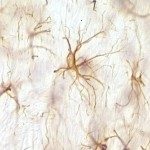Lien vers Pubmed [PMID] – 14596849
Neuroscience 2003;122(1):59-75
Tetanus neurotoxin-insensitive vesicle-associated membrane protein (TI-VAMP) is a vesicular soluble N-ethyl maleimide-sensitive fusion protein attachment protein receptor (SNARE) that has been implicated in neurite outgrowth. It has previously been reported that TI-VAMP is localised in the somatodendritic compartment of neurons indicating a role in membrane fusion events within dendrites. Using a newly produced monoclonal antibody to TI-VAMP that improves signal/noise immunodetection, we report that TI-VAMP is also present in subsets of axon terminals of the adult rat brain. Four distinctive populations of labelled axon terminals were identified: 1) the hippocampal mossy fibres of the dentate gyrus and of CA3, 2) the striatal peridendritic terminal plexuses in the globus pallidus (GP), substantia nigra pars reticulata (SNr), 3) peridendritic plexuses in the central nucleus of the amygdala, and 4) the primary sensory afferents in the dorsal horn of the spinal cord. The presynaptic localisation of TI-VAMP in these locations was demonstrated by co-localisation with synaptophysin. Ultrastructural studies showed TI-VAMP labelling over synaptic vesicles in the mossy fibres, whereas it was localised in tubulo-vesicular structures and multivesicular bodies in the pyramidal cell dendrites. The presynaptic localisation of TI-VAMP occurred by P15, so relatively late during development. In contrast, dendritic labelling was most prominent during the early post-natal period. Co-localisation with markers of neurotransmitters showed that TI-VAMP-positive terminals are GABAergic in the GP and SNr and glutamatergic in the mossy fibre system and in the dorsal root afferents. Most of these terminals are known to co-localise with neuropeptides. We found met-enkephalin-immunoreactivity in a sizeable fraction of the TI-VAMP positive terminals in the GP, amygdala, and dorsal horn, as well as in a few mossy fibre terminals. The function of TI-VAMP in subsets of mature axon terminals remains to be elucidated; it could participate in the exocytotic molecular machinery and/or be implicated in particular growth properties of the mature axon terminals. Thus, the presence of TI-VAMP in the mossy fibres may correspond to the high degree of plasticity that characterises this pathway throughout adult life.

